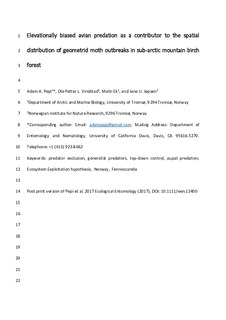Elevationally biased avian predation as a contributor to the spatial distribution of geometrid moth outbreaks in sub-arctic mountain birch forest
Journal article, Peer reviewed
Accepted version

Åpne
Permanent lenke
http://hdl.handle.net/11250/2458026Utgivelsesdato
2017Metadata
Vis full innførselSamlinger
- Publikasjoner fra CRIStin - NINA [2364]
- Scientific publications [1392]
Sammendrag
1. Population dynamics and interactions that vary over a species’ range are of particular importance in the context of latitudinal clines in biological diversity.Winter moth (Operophtera brumata) and autumnal moth (Epirrita autumnata) are two species of eruptive geometrids that vary widely in outbreak tendency over their range, which generally increases from south to north and with elevation. 2. The predation pressure on geometrid larvae and pupae over an elevational gradient was tested. The effects of background larval density and bird occupancy of monitoring nest boxes on predation rates were also tested. Predation on larvae was tested through exclusion treatments at 20 replicate stations over four elevations at one site, while pupae were set out to measure predation at two elevations at three sites. 3. Larval densities were reduced by bird predation at three lower elevations, but not at the highest elevation, and predation rates were 1.9 times higher at the lowest elevation than at the highest elevation. The rate of predation on larvae was not related to background larval density or nest box occupancy, although there were more eggs and chicks at the lowest elevation. Therewere no consistent differences in predation on pupae by elevation. 4. These results suggest that elevational variation in avian predation pressure on larvae may help to drive elevational differences in outbreak tendency, and that birds may play a more important role in geometrid population dynamics than the focus on invertebrate and soil predators of previous work would suggest. Ecosystem exploitation hypothesis, Fennoscandia, generalist predators, Norway, predator exclusion, pupal predation, top-down control.